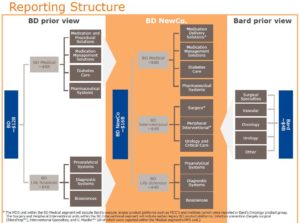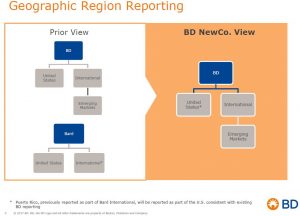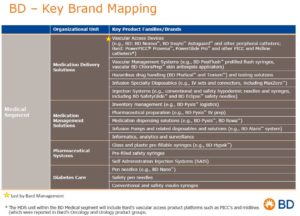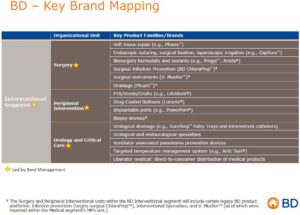Contents
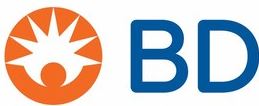 Summary
Summary
- Becton Dickinson closed the acquisition of CR Bard on December 29, 2017 thus resulting in projected FY2018 annual revenue of ~$16B versus ~$12B in FY2017.
- The company’s risk profile has changed dramatically as a result of the debt taken on to acquire CareFusion and CR Bard. Debt is now non-investment grade-speculative and lower medium grade.
- Becton Dickinson’s current stock price does not provide much margin of safety.
- Despite the weak credit ratings I am optimistic about BDX’s future. I am prepared to bide my time for a price correction before initiating any additional purchase. I also await the FY2018 projections for the combined entity which should be released January 23, 2018.
Introduction
On February 17, 2009 I initiated a position in Becton Dickinson (NYSE: BDX) by acquiring several hundred shares. I subsequently acquired another 120 shares on June 25, 2012.
At the time of my 2009 purchase, BDX had recently reported FY 2008 results of ~$7B in annual revenue, earnings per share (EPS) of $4.46, a $1.14 annual dividend which represented a 25.5% dividend payout ratio, and free cash flow (FCF) of $4.10/share.
When I acquired additional shares in 2012, BDX had reported FY 2011 results of ~$7.6B in annual revenue, earnings per share (EPS) of $5.62, a $1.64 annual dividend which represented a 29.3% dividend payout ratio, and free cash flow (FCF) of $4.91/share.
In addition to these purchases, all dividends have been automatically reinvested.
Subsequent to my share purchases, BDX has undergone a major transformation having completed the CareFusion acquisition in March 2015 and, just recently, the C.R. Bard (‘Bard’) acquisition.
In this article I quickly look at the dramatic change in BDX as a result of the Bard acquisition and provide my rationale as to why I am not prepared to acquire additional BDX shares at the current level (~$223 as at January 10, 2018).
Company Overview
In 1897, Maxwell Becton and Fairleigh Dickinson founded BDX with a vision to improve outcomes for patients.
It is now a global medical technology company engaged in the development, manufacture and sale of a broad range of medical supplies, devices, laboratory equipment and diagnostic products used by healthcare institutions, life science researchers, clinical laboratories, the pharmaceutical industry and the general public.
BDX provides customer solutions that are focused on improving medication management and patient safety; supporting infection prevention practices; equipping surgical and interventional procedures; improving drug delivery; aiding anesthesiology care; enhancing the diagnosis of infectious diseases and cancers; advancing cellular research and applications; and supporting the management of diabetes.
Prior to the Bard acquisition, BDX’s operations consisted of two worldwide business segments: BD Medical and BD Life Sciences.
BD Medical
BD Medical produces a broad array of medical technologies and devices that are used to help improve
healthcare delivery in a wide range of settings. The primary customers served by BD Medical are hospitals and clinics; physicians’ office practices; consumers and retail pharmacies; governmental and nonprofit public health agencies; pharmaceutical companies; and healthcare workers. BD Medical consists of the following organizational units:
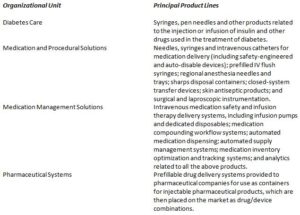 BD Life Sciences
BD Life Sciences
BD Life Sciences provides products for the safe collection and transport of diagnostics specimens, and instruments and reagent systems to detect a broad range of infectious diseases, healthcare-associated infections (“HAIs”) and cancers. In addition, BD Life Sciences produces research and clinical tools that facilitate the study of cells, and the components of cells, to gain a better understanding of normal and disease processes. That information is used to aid the discovery and development of new drugs and vaccines, and to improve the diagnosis and management of diseases. The primary customers served by BD Life Sciences are hospitals, laboratories and clinics; blood banks; healthcare workers; public health agencies; physicians’ office practices; academic and government institutions; and pharmaceutical and biotechnology companies. BD Life Sciences consists of the following organizational units:
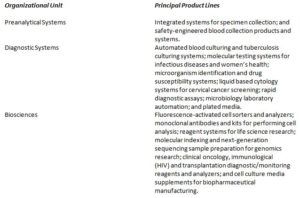 CR Bard Acquisition
CR Bard Acquisition
On April 24, 2017, BDX announced its intent to acquire Bard.
The rationale for the acquisition was to provide BDX will the ability to become a medical technology leader in the fields of vascular, urology, oncology and surgical specialty products. These were areas in which BDX had no/limited exposure.
Through this merger, BDX has created a highly differentiated medical technology company uniquely positioned to improve both the process of care and the treatment of disease for patients and healthcare providers.
BDX has brought to the table a leadership position in medication management and infection prevention with an expanded offering of solutions across the care continuum. Bard has brought a strong product portfolio and innovation pipeline which now enables BDX to:
- greatly improve BDX’s opportunities in fast-growing clinical areas;
- enhance growth opportunities in non-U.S. markets.
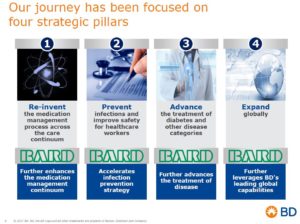
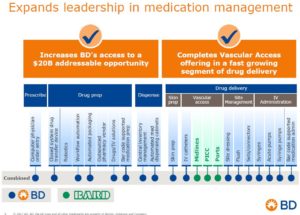
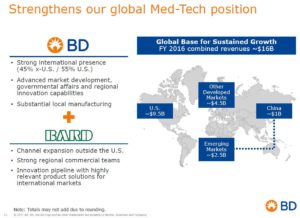
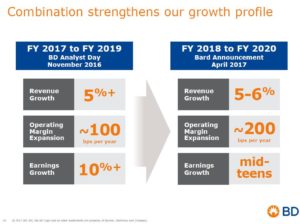
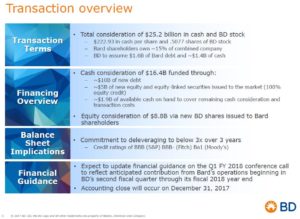
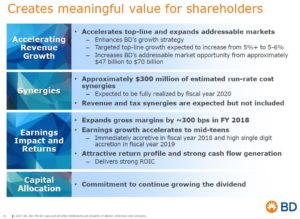 Source: BDX April 24, 2017 presentation
Source: BDX April 24, 2017 presentation
On December 28, 2017, BDX closed its previously announced acquisition of Bard. With this acquisition, BDX has been reorganized as reflected below.
Source: BDX December 29, 2017 presentation
As part of management’s commitment to deleverage to below 3x debt/equity over 3 years, cost synergies of ~$300 million over 3 years through fiscal 2020 are projected.
Competition
BDX operates in the increasingly complex and challenging medical technology marketplace. Technological advances and scientific discoveries have accelerated the pace of change in medical technology, the regulatory environment of medical products is becoming more complex and vigorous, and economic conditions have resulted in a challenging market. Companies of varying sizes compete in the global medical technology field.
Some of BDX’s competitors are more specialized with respect to particular markets, and some have greater financial resources. In addition, new companies have entered the field, particularly in the areas of molecular diagnostics, safety-engineered devices and in the life sciences, and established companies have diversified their business activities into the medical technology area.
Other firms engaged in the distribution of medical technology products have become manufacturers of medical devices and instruments as well. Acquisitions and collaborations by and among companies seeking a competitive advantage also affect the competitive environment. In addition, the entry into the market of low-cost manufacturers is creating increased pricing pressures. Some competitors have also established manufacturing sites or have contracted with suppliers located in these countries as a means to lower their costs.
Change in Credit Ratings
BDX’s risk profile has changed dramatically over the past decade as evidenced by the following chart. It was once a company rated high grade/upper medium grade. Currently it is rated as non-investment grade-speculative and lower medium grade. Refer to ratings metrics.
 Readers who currently hold BDX or are contemplating the possibility of initiating a position in BDX must be cognizant of this change in BDX’s risk profile.
Readers who currently hold BDX or are contemplating the possibility of initiating a position in BDX must be cognizant of this change in BDX’s risk profile.
2018 Financial Guidance
On January 9, 2018 at the 36th Annual J.P. Morgan Healthcare Conference, BDX provided the following FY2018 guidance which included the recent Bard acquisition.


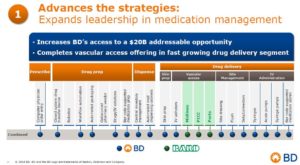
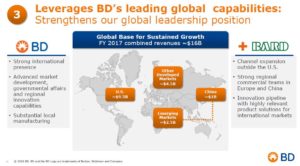
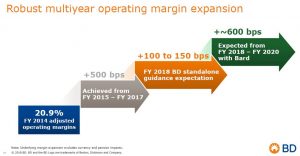 Source: BDX January 9, 2018 36th Annual J.P. Morgan Healthcare conference
Source: BDX January 9, 2018 36th Annual J.P. Morgan Healthcare conference
Dividends, Dividend Yield, and Dividend Payout Ratio
BDX is a member of the Dividend Aristocrats group since it has a history of having increased its annual dividend for 25+ years in a row; BDX’s dividend and stock split history can be found here.
Not only does BDX have this enviable track record, the compound annual growth rate over the last several years has been in the low double digits.
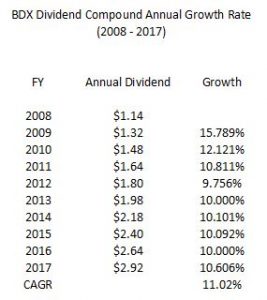 The dramatic run-up in BDX’s stock price in recent years, however, has outpaced the dividend growth thus resulting in a sub 1.50% dividend yield.
The dramatic run-up in BDX’s stock price in recent years, however, has outpaced the dividend growth thus resulting in a sub 1.50% dividend yield.
The other drawback is that BDX’s dividend payout ratio has deteriorated dramatically over the past 10 years. In FY2008, BDX’s dividend payout ratio was ~25.5%. In FY2017, the dividend payout ratio had increased to ~83%.
Valuation
A dozen analysts have forecast adjusted EPS of $10.87 for FY2018. Based on the ~$223.7 closing stock price on January 10 2018, the current adjusted PE ratio is ~20.6.
On November 2, 2017, BDX provided stand alone guidance of 2018 adjusted EPS of $10.55 – $10.65. Based on the January 10, 2018 closing stock price, we get a ~21 forward adjusted PE ratio.
While level is reasonable for a company growing to the extent in which BDX is growing, I view it as somewhat rich for a company rated non-investment grade.
I am also somewhat concerned there is an element of irrational exuberance which has contributed to the dramatic increase in BDX’s stock price subsequent to the April 2017 announcement of the Bard acquisition.
I look forward to January 23, 2018 at which time BDX will release its Q1 2018 results and guidance for the combined BDX/Bard entity. Until I have had an opportunity to review management’s projections, however, I am of the opinion that BDX is too rich to warrant my acquisition of any additional shares.
Becton Dickinson – Final Thoughts
BDX’s risk profile has certainly changed over the years as a result of the sizable CareFusion and Bard acquisitions.
While BDX certainly has significantly greater growth potential as a result of these acquisitions, I think it is important investors be cognizant that BDX’s level of risk has significantly increased as a result of the additional debt taken on to complete these acquisitions.
Management is well aware of the elevated risk level and has indicated it intends to significantly reduce leverage over the next few years through:
- an acceleration in top line revenue;
- the realization of $300 million in synergistic cost savings by 2020;
- a 300 basis point expansion in gross margins.
I am confident they will be able to achieve the above, and therefore, I am not prepared to liquidate our existing shares. I would even be willing to acquire additional shares despite the weak credit ratings but I first want to see management’s impending forecast for FY2018. I would also like to see BDX’s stock price retrace wherein the forward PE ratio based on adjusted EPS is slightly below 20.
I wish you much success on your journey to financial freedom.
Thanks for reading!
Note: I sincerely appreciate the time you took to read this post. As always, please leave any feedback and questions you may have in the “Contact Me Here” section to the right.
Disclaimer: I have no knowledge of your individual circumstances and am not providing individualized advice or recommendations. I encourage you not to make any investment decision without conducting your own research and due diligence. You should also consult your financial advisor about your specific situation.
Disclosure: I am long BDX.
I wrote this article myself and it expresses my own opinions. I am not receiving compensation for it and have no business relationship with any company whose stock is mentioned in this article.


